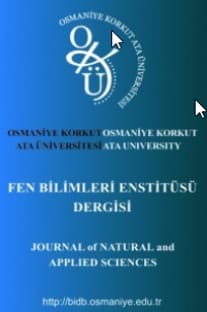Atık Mantar Kompostunun Hayvan Beslemede Kullanım Olanakları
Usage Opportunities of Waste Mushroom Composite In Animal Nutrition
___
- [1] Kumar S., Chandra R. Bioconversion of agricultural wastes for production of milky mushroom (Calocybe indica), Journal of Scientific Research 2013; 57, 65-76.
- [2] Atila F. A useful way to dispose of phenolic-rich agro-industrial wastes: Mushroom cultivation, EJENS 2019; 3(2): 32-41.
- [3]. Özdemir P. Atık mantar kompostunun yem değerinin belirlenmesi ve erkek kuzularda besi performansına etkisi, Tarımsal Araştırmalar ve Politikalar Genel Müdürlüğü Yeni Teklif Projesi 2020, Ankara.
- [4] Calzada JF., Franco LF., Arriola MC de., Rolzand C., Ortiz MA. Acceptability, body weight changes and digestibility of spent wheat straw after harvesting of pleurotus sajor-caju fed to lambs, Biol Waste 1987; 22(4): 303-309.
- [5] Zadrazil F. Changes in in vitro digestibility of wheat straw during fungal growth and after harvest of oyster mushrooms (Pleurotus spp.) on laboratory and industrial scale, Journal of Applied Animal Research 1997; 11(1): 37-48.
- [6] Fazaeli H., Jelan ZA., Azizi A., Liang JB., Mahmodzadehand H., Osman A. Effects of fungal treatment on the nutritive value of wheat straw, Malaysian Journal of Animal Science 2002; 7(2): 61-71.
- [7] Fazaeli H., Masoodi ART. Spent wheat straw compost of Agaricus bisporus mushroom as ruminant feed, Asian-Australasian Journal of Animal Sciences 2006; 19(6): 845-851.
- [8] Rai RD., Sohi HS. How protein rich are mushrooms, Indian Hort 1988; 33, 2-3.
- [9] Langar PN., Sehgal JP., Rana VK., Singh MM., Garcha HS. Utilization of Agaricus bisporus-harvested spent wheat straw in the ruminant diets, Indian Journal of Animal Science 1982; 52(8): 634-637.
- [10] Durrant AJ., Woodand DA., Cain RB. Lignocellulose biodegradation by Agaricus bisporus during solid substrate fermentation, J Gen Microbiol 1991; 137, 751-755.
- [11] Zhang CK., Gong F., Li DS. A note on the utilisation of spent mushroom composts in animal feeds, Bioresource Technology 1995; 52, 89-91.
- [12]Oh YK., Lee WM., Choi CW., Kim KH., Hong SK. Effects of spent mushroom substrates supplementation on rumen fermentation and blood metabolites in Hanwoo steers, AsianAustralian Journal of Animal Science 2010; 23, 1608-1613.
- [13] Lee TT., Ciou JY., Chiang CJ., Chao YP., Yu B. Effect of pleurotus eryngii stalk residue on the oxidative status and meat quality of broiler chickens, Journal of Agriculture Food Chem, 2012; 60, 11157-11163.
- [14] Foluke A., Olutayo A., Olufemi A. Assessing spent mushroom substrate as a replacement to wheat bran in the diet of broilers, American International Journal of Contemporary Research 2014; 4(4): 178-183.
- [15] Ehtesham SH., Vakili AR. The effect of spent mushroom substrate on blood metabolites and weight gain in kurdish male lambs, Entomology and Applied Science Letters 2015; 2(1): 29-33.
- [16] Lai LP., Lee MT., Chen CS., Yu B., Lee TT. Effects of co-fermented Pleurotus eryngii stalk residues and soybean hulls by Aureobasidium pullulans on performance and intestinal morphology in broiler chickens, Poultry Science 2015; 94(12): 2959-2969.
- [17] Wang CL., Chiang CJ., Chao YP., Yu B., Lee TT. Effect of Cordyceps militaris waster medium on production performance, egg traits and egg yolk cholesterol of laying hens, Journal of Poultry Science 2015; 52, 188-196.
- [18] Baek YC., Kim MS., Reddy KE., Oh YK., Jung YH., Yeo JM., Choi H. Rumen fermentation and digestibility of spent mushroom (Pleurotus ostreatus) substrate inoculated with Lactobacillus brevis for Hanwoo steers, Revista Colombiana de Ciencias Pecuarias 2017; 30(4): 267-277.
- [19] Kalvandi S., Zaboli KH., Malecky M. Effect of spent mushroom compost (Agaricus bisporus) silage processing on its chemical composition, digestibility and ruminal fermentation kinetic in Mehraban sheep, Animal Production Research 2018; 7(2): 69-82.
- [20] Mahfuz S., Song H., Liu Z., Liu X., Diao Z., Ren G., Guo Z., Cui Y. Effect of golden needle mushroom (Flammulina velutipes) stem waste on laying performance, calcium utilization, immune response and serum immunity at early phase of production, Asian Australian Journal of Animal Science 2018; 31(5): 705-711.
- [21] Maleko D., Mwilawa A., Msalya G., Pasape L., Mtei K. Forage growth, yield and nutritional characteristics of four varieties of napier grass (Pennisetum purpureum Schumach) in the west Usambara highlands, African Crop Science Journal 2019; 6, e00214.
- [22] Wang CC., Lin LJ., Chao YP., Chiang CJ., Lee MT., Chang SC., Yu B., Lee TT. Antioxidant molecular targets of wheat bran fermented by white rot fungi and its potential modulation of antioxidative status in broiler chickens, British Poultry Science 2017; 58, 262-271.
- [23] Mahfuz S., He T., Liu S., Wu D., Long S., Piao X. Dietary inclusion of mushroom (flammulina velutipes) stem waste on growth performance, antibody response, immune status, and serum cholesterol in broiler chickens, Animals 2019; 9, 692.
- [24] Chuang WY., Liu CL., Tsai CF., Lin WC., Chang SC., Shih HD., Shy YM., Lee TZ. Evaluation of waste mushroom compost as a feed supplement and ıts effects on the fat metabolism and antioxidant capacity of broilers, Animals 2020; 10, 445.
- [25] Tesfay T., Godifey T., Mesfin R., Kalayu G. Evaluation of waste paper for cultivation of oyster mushroom (Pleurotus ostreatus) with some added supplementary materials, AMB Expr 2020; 10, 15.
- ISSN: 2687-3729
- Yayın Aralığı: Yılda 3 Sayı
- Başlangıç: 2017
- Yayıncı: Osmaniye Korkut Ata Üniversitesi
Çok Robotlu Üretim İstasyonlarında Çarpışma Olmaması İçin Çalışma Alanı Yönetimi
Dolgu Duvarların Düzlem İçi ve Düzlem Dışı Davranışına Esnek Derzli Bağlantı Elemanının Etkisi
Osman Fatih BAYRAK, MUHAMMET MUSAB ERDEM, Murat BİKÇE, ENGİN EMSEN
Arı Ürünlerine Genel Bir Bakış
Semiramis KARLIDAĞ, Merve KESKİN
Turan ARSLAN, Mohammad Mahdi HOSSAİNY
Trafik Kaza Sayısının ve Yaralı Sayısının Yapay Sinir Ağları ile Tahmini
Ömer Faruk CANSIZ, İbrahim ERGİNER, Merve ERGİNER
Atık Mantar Kompostunun Hayvan Beslemede Kullanım Olanakları
İnsan ve Hayvan Beslenmesinde Chia (Salvia hispanica) Kullanılması
Entansif Şartlarda Yetiştirilen Kıvırcık Kuzularda Kan Plazması ve Yapağıdaki Çinko ve Bakır Profili
Hüseyin ESECELİ, Cüneyt KAPTAN, Harun KARADAĞ, Selim ESEN
Selim ESEN, Harun KARADAĞ, Cüneyt KAPTAN, Hüseyin ESECELİ
Cam Tozu Katkılı Lifli Harçların Fiziksel ve Mekanik Özellikleri
